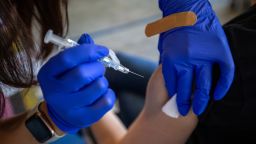The World Health Organization is opening up the definition of airborne pathogens – such as Covid-19, influenza and measles – to include when respiratory droplets spread through the air and when they land on a person, regardless of the size of the droplet.
The new report aims to cut down on the confusion around how to “describe the transmission of pathogens through the air that can potentially cause infection in humans,” according to WHO.
The phrase “transmission through the air” can be used to describe when infectious respiratory particles become airborne and spread, and the subcategories of “airborne transmission” and “direct deposition” can both fall under this blanket phrase, according to a WHO technical report published Thursday and developed in consultation with hundreds of scientists under a WHO Technical Consultation Group.
“Airborne transmission” refers to when infectious respiratory particles expel into the air, such as from coughing or sneezing, and enter the respiratory tract of another person who inhales them, according to WHO. The subcategory “direct deposition” refers to when infectious respiratory particles expel into the air and directly land on another person’s mouth, nose or eyes, potentially causing infection.
Those descriptors can involve particles “on a spectrum of sizes” that may expel over both short and long distances, according to WHO. That means there is no threshold or cut-off of particle size when using the updated terminology.
“This report is important because it will enable better, clearer communication with the public about transmission of pathogens and how to reduce the risk of transmission,” Linsey Marr, an aerosol scientist and professor at Virginia Tech, who is a member of the consultation group behind the new report, said in an email Thursday.
“Prior to this, a flawed understanding of airborne transmission of infectious diseases caused a lot of miscommunication about how Covid-19 was transmitted and how people could best protect themselves. For example, wiping down groceries was not a good use of our time,” Marr said. “Public health agencies were hesitant to use the word ‘airborne’ because of differences in understanding among experts about what it meant. I hope that this report will allow public health communicators to use the word ‘airborne’ because this word is the simplest and clearest way to explain to the average person how a disease might be transmitted.”
The WHO report said that the new terminology for airborne pathogens is consistent with how other diseases may be described, such as “waterborne” or “bloodborne.”
“The descriptors included in this document should be seen as a starting point for further evidence review, urgent and detailed discussions and, multidisciplinary research with associated funding,” according to the report.
The terminology in the new report can help scientists from across disciplines find agreement and clarity in describing airborne pathogens, Jeremy Farrar, WHO chief scientist, said in a video statement Thursday.
“What this document does is bring the disciplines together and get common agreement. When I say ‘aerosol’, when I say ‘through the air’, it doesn’t matter whether I’m an engineer, a clinician, a nurse, a public health person. We know we mean the same thing,” Farrar said. “This actually covers many, many respiratory infections that go through the air. And that is also, I think, historic.”
The need for such consensus was evident at the peak of the Covid-19 pandemic.
‘There were many failures’
During the pandemic, various terms were used in different ways to describe how the coronavirus could spread, causing much confusion – terms like airborne, airborne transmission or aerosol transmission.
“We could all see that the different disciplines were describing things in different ways. People from all of those scientific expertise were using different languages, and therefore they were in some ways talking past each other rather than working together,” Farrar said.
Around that same time, a group of scientists urged WHO to be more forthcoming about the likelihood that people can catch the virus from droplets floating in the air.
If the new WHO report had been in place before the Covid-19 pandemic, “public health officials might have described transmission as ‘airborne’ and recommended high-quality masks immediately, emphasized the importance of good ventilation indoors, and reduced the emphasis on distancing and hand-washing,” Marr said.
The new report addresses a problem that Dr. Jessica Justman, professor of medicine in epidemiology and infectious disease expert at Columbia University Vagelos College of Physicians and Surgeons, said she puzzled over when Covid-19 first emerged – whether coronavirus aerosols versus droplets were more important in transmission.
“Respiratory particles exist in a wide continuum of sizes yet for decades, we used a cut-off of 5-10 microns, below which particles were considered aerosol and above which they were considered droplets,” Justman, who was not involved in the new WHO report, said in an email Thursday. “This use of a cut-off size never seemed logical to me and this report recommends we no longer use a cut-off size and instead suggests we view it as the continuum that it is.”
Get CNN Health's weekly newsletter
- Sign up here to get The Results Are In with Dr. Sanjay Gupta every Friday from the CNN Health team.
The new report “is an improvement,” as it somewhat clarifies the terminology that was used for many years to describe airborne transmission involving larger and smaller particles, Stephen S. Morse, professor of epidemiology at Columbia University Mailman School of Public Health, said in an email Thursday.
With the Covid-19 virus, “some agencies and scientists erroneously believed the spread was only by droplets, which don’t travel as far as the smaller particles. It took some time to recognize that both can enable transmission. This is probably true of most, probably all, respiratory viruses, although the specifics might vary,” said Morse, who was not involved in the new WHO report.
“There were many failures in dealing with the pandemic, it would have been useful to have greater clarity but I don’t think it would have made a great difference overall,” he said. “It would have helped people to better protect themselves, but we didn’t have appropriate personal protective equipment available anyway.”






